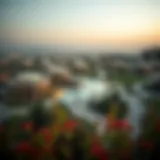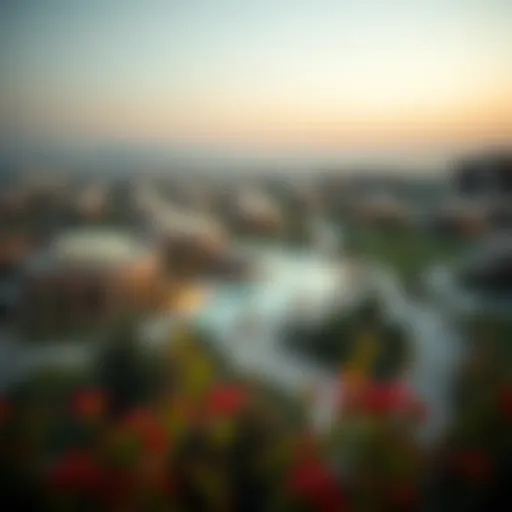Exploring Dubai's Largest Park: Features and Impact
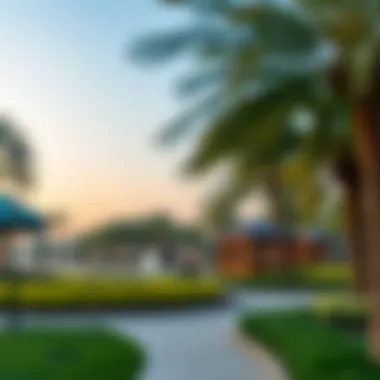

Intro
Dubai, a city often hailed for its modern architecture and luxurious lifestyle, also boasts green spaces that serve as a refreshing counterbalance to its urban landscape. Among these, the largest park stands out, not just as a place for recreation but as a vital contributor to the city’s environmental sustainability and community development. In understanding this park's essence, it's essential to examine how it integrates nature into the fast-paced life of Dubai, offering its residents and visitors a breath of fresh air amid the towering skyscrapers.
The narrative around this park encompasses not only its physical attributes but also its symbolic significance in promoting well-being and social cohesion. This article will take a comprehensive look at what makes this park the crown jewel of Dubai’s outdoor spaces, highlighting its design, amenities, and the role it plays in the local community.
As we explore this green oasis, we will touch upon the historical evolution of parks in Dubai, how they have become more than mere patches of grass, and their impact on sustainable urban living. Expect insights into the park's features—ranging from walking trails and sports facilities to picnic areas—and discover how these elements come together to create an inviting public space.
Furthermore, we will expand on practical visitor information, including the best times to visit, available amenities, and what to anticipate when wandering through this expansive area.
In subsequent sections, we’ll also analyze the broader implications of such green spaces in urban planning and how they contribute to a healthier environment.
Through a meticulous look at various dimensions of Dubai’s largest park, this piece aims to be a go-to guide for both residents and tourists, enriching their experience with knowledge and appreciation of this remarkable public space. But first, let us turn our attention to the current market dynamics surrounding recreational areas in the city.
Intro to Dubai's Green Spaces
Green spaces in urban settings are not just a luxury; they are a necessity. In a city as bustling as Dubai, where the skyline is punctuated by towering buildings and commercial establishments, parks play a pivotal role. They provide a slice of nature amidst a concrete jungle, allowing residents and visitors to connect with the outdoors, unwind, and engage in recreational activities. These spaces foster community interaction and contribute positively to mental and physical well-being.
The Importance of Parks in Urban Environments
Parks serve multiple functions in urban areas. They are vital for ecological balance, act as lungs for the city, and offer a habitat for local fauna. For the residents, these green areas offer a reprieve from the fast-paced life of the city. As a community, parks can host gatherings, promote cultural events, and act as venues for festivals and celebrations. The opportunity for physical activity is substantial; walking, jogging, or simply sitting in the shade of a tree promotes health and well being.
Moreover, parks enhance property values. For investors, agents, and homebuyers, proximity to parks often translates to increased desirability. Properties near well-maintained green spaces typically experience a premium price. This is not merely anecdotal; studies show that homes near parks are often valued higher in the local real estate market.
Furthermore, parks can help mitigate urban heat effects. The mere presence of trees and green foliage can lower temperatures in urban environments. As cities strive for sustainability, integrating parks into planning and development becomes critical for improving environmental quality.
Historical Development of Parks in Dubai
Dubai's journey towards establishing green spaces began in the 1970s, during a time of rapid urbanization. Initially, efforts were made to create simple landscapes in residential areas, but the vision shifted as the city advanced. By the 1990s, the government recognized the need for dedicated parks, instituting various projects to enhance urban greenery. The arrival of parks such as Al Safa Park and Zabeel Park marked significant milestones in this evolution.
Today, Dubai's commitment to green spaces can be seen in large parks and the preservation of old flora, such as ghaf trees, which hold cultural significance. Moreover, the government aims to increase the percentage of green areas in alignment with the Dubai Urban Master Plan. The ambition is to achieve better harmony between urban living and nature.
"The green spaces in Dubai are a testament to the city’s commitment to improving quality of life, offering both beauty and recreational opportunities."
Overview of Dubai's Largest Park
Exploring the largest park in Dubai is like wandering into an oasis amidst the bustling urban sprawl. This park doesn't just serve as a green escape but also plays a pivotal role in the city’s ecosystem and community dynamics. Understanding the layout and primary features of this park is essential, as it highlights the efforts of Dubai to integrate greenery into its futuristic landscape. Moreover, the park offers benefits that extend beyond mere leisure; it embodies the spirit of sustainable urban living by providing habitats for various species and improving air quality.
Park Location and Accessibility
Located at the heart of the city, the largest park in Dubai is easily accessible to both tourists and locals. Its proximity to key residential and commercial areas makes it a favored destination. The park’s entrance aligns well with major roads and metro stations, ensuring that people can reach it without much hassle. For those relying on public transport, the Dubai Metro offers convenient stops nearby, while ample parking spaces are available for those who prefer to drive. The accessibility aspect solidifies its role as a communal hub, allowing a diverse mix of visitors to enjoy its beauty.
Size and Features of the Park
When it comes to size, this park stands out significantly in the region. Covering over a massive area of approximately 1,200 acres, it offers a blend of lush landscapes, walking paths, and recreational spots. The park is home to various species of flora, making it not just a place for relaxation but also a mini-biodome where nature thrives amidst the urban surroundings. Notable features include:
- Walking and Cycling Tracks: Winding through the greenery, the tracks invite fitness enthusiasts and leisurely strollers alike, promoting an active lifestyle.
- Picnic Areas: Scattered throughout, these zones are perfect for family gatherings, complete with tables and grills for barbeque.
- Water Bodies: The serene lakes appeal to both visitors and wildlife, adding to the park’s tranquil ambiance.
In essence, the vastness and meticulously planned features of Dubai's largest park not only elevate its natural beauty but also underscore the importance of integrating green spaces within urban frameworks.
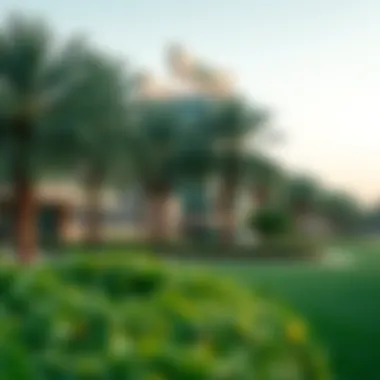

Design and Landscape Architecture
Design and landscape architecture play a pivotal role in shaping the aesthetic and functional aspects of Dubai's largest park. This section will explore how thoughtful planning creates not only a visually appealing environment but also a space that fosters community interaction and environmental sustainability. By integrating natural elements into the design, landscape architects can create a harmonious balance between urban development and nature. This not only enhances the park's beauty but also promotes biodiversity and ecological health within the urban landscape.
Incorporation of Natural Elements
Incorporating natural elements in landscape design is more than just planting a few trees. It's about creating an immersive environment that connects visitors with nature. For instance, the integration of native plant species reduces water usage and maintenance while supporting local wildlife. Imagine walking through a park where the fragrance of jasmine fills the air, and the vibrant colors of bougainvillea soften the urban palette. This creates a serene atmosphere that encourages people to relax and unwind. Furthermore, incorporating water features like ponds or fountains can provide natural cooling, helping to mitigate the harsh Dubai sun.
Using topography is also key. By utilizing the natural contours of the land, designers can create picturesque trails, hillside looks, and natural barriers that enhance the park's topography. Notable examples include the strategic placement of greenery that not only beautifies the park but also contributes to its microclimate. This foresight in design elevates the user experience while respecting the balance of ecosystems. The beauty of the park then becomes a collective tapestry woven together by both flora and fauna.
Innovative Landscape Design Techniques
When it comes to innovative landscape design techniques, advancements in technology and sustainability are making waves. One advancing method includes the use of drainage systems that cleverly combine aesthetics with practicality. These systems can design rain gardens that filter pollutants while providing a lush green space for park-goers.
Another noteworthy technique is the implementation of sustainable irrigation systems, which harness rainwater and recycle greywater. Such measures not only conserve water but also ensure that the park remains vibrant year-round.
Additionally, vertical gardens and green roofs are catching on in urban parks. These can transform ordinary buildings into living sculptures, thus contributing to urban greening efforts. Parks might use walls or structures that grow plants, which is especially picturesque in a bustling metropolis like Dubai where space is at a premium.
"The beauty of innovative design lies in its ability to surprise and delight, molding landscapes that reflect both culture and the environment."
All these elements combined work toward creating a more engaging experience. They form places where people want to gather, exercise, and spend time with family, thereby serving both aesthetic and functional needs in the urban setting. This thoughtful design enhances community engagement and paves the way for a greener future in Dubai.
Amenities and Activities
Parks play a crucial role in urban environments, and the largest park in Dubai is no exception. The amenities and activities available within this park provide a multifaceted experience that appeals to various demographics. From recreational activities to community engagement, these elements enhance the quality of life for residents and visitors alike. Not only do they create opportunities for leisure and fitness, but they also foster social connections and engagement among people of varied backgrounds. Thus, the importance of examining these aspects cannot be understated.
Sports Facilities and Recreational Areas
The largest park in Dubai boasts an impressive array of sports facilities and recreational areas designed to cater to all kinds of fitness enthusiasts. Jogging tracks skirt the park’s perimeter, offering a serene path for those eager to maintain their exercise routine amidst a green setting. Cycling paths wind through vibrant flora, inviting daily commuters or weekend warriors alike.
An array of sports courts can be found throughout the park, including basketball and tennis facilities. These courts are often buzzing with activity, fostering friendly competition and encouraging healthier lifestyles. Facilities for football and cricket also attract group games, where spontaneous matches often spring up, bringing together users who share a passion for these sports.
Moreover, open fields provide a space for picnics, yoga classes, or simply for sunbathers to unwind on a warm day. The appeal of these recreational areas goes beyond mere fun— they serve as local hubs where people can socialize, forge friendships, and create lasting memories.
Children's Play Areas
Children are likely to find themselves enchanted by the thoughtfully designed play areas within the park. Safety and creativity are key components here; with a variety of play structures and equipment, children can immerse themselves in imaginative games while parents can feel at ease knowing their little ones are secure.
From climbing walls and slides to swings and sandpits, the park’s play spaces cater to different age groups and abilities. Additionally, sensory gardens provide unique interactive experiences, allowing young visitors to engage with nature through touch, smell, and sight. These dedicated zones encourage kids to explore, learn, and enjoy the great outdoors—an essential contrast to the often digitized leisure activities they encounter elsewhere.
Event Spaces and Community Engagement
This park acts as a melting pot for community interaction, thanks to its dedicated event spaces. Throughout the year, various cultural events, festivals, and workshops take place here, drawing participants from Dubai’s diverse population. These events are pivotal in creating a sense of belonging among residents, making it a true community hub.
The park often hosts art exhibitions, local farmers' markets, and music performances. Such gatherings enable budding artists, artisans, and performers to showcase their talents while fostering support from local residents.
Additionally, there are open-air venues designated for movie nights and theater performances, adding a layer of entertainment that appeals to all ages. As individuals and families immerse themselves in these activities, they share in the richness of cultural exchange, enhancing the social fabric of the community.
The success of parks isn’t merely defined by their size, but by how effectively they foster community interaction and offer engaging activities. In Dubai's case, the largest park stands as testament to the city’s commitment to enhancing social well-being.
Environmental Impact and Sustainability
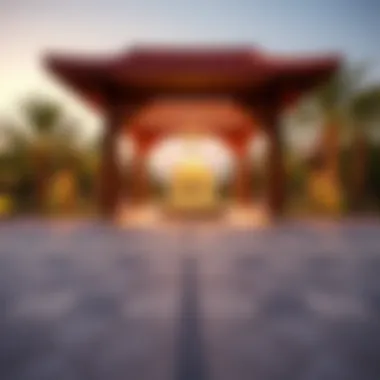

In recent years, cities around the globe have started recognizing the immense value of parks in promoting urban sustainability and environmental health. This section delves into two pivotal aspects: the role of parks in urban ecology and the sustainable practices that govern their management. Understanding these elements is essential, given the rapid development and urbanization Dubai has been undergoing. It's vital to examine how green spaces can contribute positively to this growth whilst mitigating environmental drawbacks.
Role of Parks in Urban Ecology
Parks are more than just patches of green in concrete jungles. They serve as crucial ecosystems that foster biodiversity. The largest park in Dubai plays a significant role in maintaining ecological balance by providing habitat for various flora and fauna. Here are some key points regarding its importance:
- Biodiversity Support: The park hosts a variety of plants that can attract numerous species of birds and insects, thus maintaining local biodiversity. This can create a vibrant ecosystem right within the heart of the city.
- Air Quality Improvement: Green spaces assist in purifying the air by absorbing pollutants and releasing oxygen. Parks can help offset the pollution endemic to urban areas, offering healthier air to residents and visitors alike.
- Urban Heat Island Mitigation: Urban spaces often suffer from the urban heat island effect, where temperatures are significantly warmer than in surrounding rural areas. Parks help cool the environment through shade provision and moisture released from plants, making the hottest months more bearable.
"Green spaces are inserted lifelines that breathe life into urban settings, enhancing both the environment and quality of life for their inhabitants."
The interconnectedness of parks and urban ecology also significantly contributes to stormwater management. Parks facilitate the absorption of rainwater, which not only reduces the risk of flooding but also replenishes groundwater. This is especially vital in areas like Dubai, where water scarcity can be a concern.
Sustainable Practices in Park Management
To maintain the ecological integrity of large urban parks, sustainable management practices are indispensable. The largest park in Dubai implements a range of techniques to ensure its ongoing health and functionality in coordination with environmental goals:
- Native Plant Use: By planting native species, the park minimizes water usage and encourages local wildlife to thrive, thus retaining the natural character of the area.
- Water Conservation: Innovative irrigation systems, such as drip irrigation, are key to managing water resources efficiently. This method can drastically reduce water waste, which is vital in arid climates.
- Waste Management: The park emphasizes reducing, reusing, and recycling waste produced within its boundaries. Strategically placed recycling bins encourage visitors to dispose of waste responsibly.
- Education Programs: Community engagement through workshops and events about sustainable practices creates a sense of ownership among residents, fostering a culture of responsibility towards the environment.
Cultural Significance of the Park
Cultural significance extends beyond mere aesthetic appreciation or recreational use; it encapsulates how a space like Dubai's largest park fosters community bonds and enriches the lives of its visitors. At its core, parks are more than just open spaces; they're essential threads in the urban fabric, providing a platform for social interaction and cultural exchange. In a city as diverse as Dubai, the park acts as a melting pot where individuals from various backgrounds can come together, share experiences, and participate in a collective narrative that strengthens societal ties.
Parks as Community Hubs
Parks serve as vital community hubs, bridging gaps between different cultures and creating environments where residents can engage with each other. In many respects, they are the heartbeats of neighborhoods, offering a respite from the bustling urban landscape while encouraging a culture of inclusivity.
- Social Interaction: The park's layout includes open spaces for picnics, sports, and casual gatherings, ensuring there's something for everyone. Families and friends frequently gather to celebrate birthdays, host picnics, or simply unwind amidst nature.
- Cultural Gatherings: It also acts as a stage for cultural exchanges, where events can celebrate Emirati traditions alongside those from expatriate communities. These gatherings often include art fairs, cultural exhibitions, and local food festivals, creating opportunities for learning and appreciation among diverse populations.
- Volunteer Programs: The park harbors volunteer initiatives where individuals can contribute to its maintenance or partake in tree-planting activities. Such programs reinforce community bonds and foster a sense of ownership among the local populace.
Events and Festivals Held in the Park
The hosting of events and festivals in the park adds another layer to its cultural significance, making it a cornerstone in Dubai's social calendar. These gatherings not only draw locals but also attract tourists, amplifying the park's role in Dubai's ever-growing tourism sector.
- Annual Cultural Festivals: Several annual events showcase local and international arts, music, and food. For instance, the Dubai Shopping Festival often includes art installations and live performances held within the park, turning it into a vibrant hub of activity.
- Seasonal Festivities: During holidays such as Eid or National Day, the park transforms into a venue for celebrations featuring markets, fireworks, and exhibitions. This creates a unique atmosphere where traditions are honored in a communal setting.
- Eco-Friendly Initiatives: The park also hosts environmental awareness programs and sustainability events. Such initiatives educate the public about conservation efforts while reinforcing the importance of green spaces in urban areas.
Parks like this one play an integral role in enhancing the quality of life for residents, not just by providing recreational opportunities but also by bridging cultural divides and fostering a sense of community.
In summary, the cultural significance of Dubai’s largest park cannot be overstated. Its function as a community hub and event space reflects its role in the social fabric of the city, making it an essential part of everyday life for both residents and visitors. As such, the preservation and promotion of such spaces are crucial for the relentless march toward a greener, more inclusive Dubai.
Challenges Faced by the Park
Parks in urban settings like Dubai are vital for enhancing quality of life and supporting ecological balance. However, they are not without their challenges. Understanding these difficulties is crucial for stakeholders involved in urban development, conservation efforts, and community engagement. Addressing these challenges not only preserves the park's value but also enhances its role as a communal hub for relaxation and recreation.
Urbanization and Its Effects
Urbanization is a double-edged sword. On one side, it drives economic growth and infrastructure development, while on the other, it poses a plethora of challenges for large parks. In Dubai, rapid urbanization often leads to increased pressure on green spaces, turning once quiet retreats into bustling areas filled with noise and foot traffic.
- Shrinking Green Spaces: As more buildings go up, the land available for parks dwindles. This shrinkage can lead to overcrowding in existing parks, where visitors might feel hemmed in rather than embraced by nature. The balancing act between development and preservation is tricky, and at times, parks bear the brunt.
- Pollution Concerns: Increased vehicle emissions and litter from nearby urban areas impact the natural beauty of the park. The park’s ecosystems face threats from air and soil pollution, which can disrupt the delicate balance that supports plant and animal life.
- Changing Visitor Demographics: As more people flock to Dubai, the park's users become more diverse. While this brings vibrancy, it can also complicate park management, as different groups have varying expectations and needs.
Overall, the effects of urbanization challenge the essence of what parks stand for in a city like Dubai.


Maintenance and Conservation Efforts
Ensuring that a large park remains a thriving green space involves diligent maintenance and thoughtful conservation efforts. Successful upkeep requires collaboration between various stakeholders, including government bodies, local communities, and conservationists.
- Funding and Resources: Getting enough funding for maintenance can be a tricky proposition. Cities often have limited budgets, and parks can be one of the first areas to see cuts during financial downturns. Volunteer programs or local fundraising can provide much-needed support but are rarely a complete solution.
- Conservation Activities: Regular maintenance must go beyond mere appearance; it involves significant conservation work. This includes protecting native species of plants and animals, removing invasive species, and ensuring that the park's environment is suitable for wildlife habitation. It's a constant battle to maintain biodiversity against the backdrop of shifting urban landscapes.
- Community Involvement: Engaging the local community in maintenance efforts can foster a sense of ownership and responsibility. Not only does this approach help keep the park clean and well-maintained, it instills a stronger connection between residents and their green oasis. However, harnessing community support can be challenging, as busy lifestyles can make regular participation difficult.
Future Prospects for Urban Green Spaces in Dubai
Urban green spaces have become a pivotal part of city planning, particularly in a place as dynamic as Dubai. The future prospects of these spaces are of utmost importance, not only for enhancing the aesthetic appeal of the city but also for promoting sustainability and improving the quality of life for residents.
The prospect of further developing parks and green areas reflects a broader commitment to creating a healthier, more balanced urban environment. As populations grow and urban areas continue to expand, community leaders recognize the necessity of providing ample green spaces for recreation, rest, and refuge. This is especially true in a booming metropolis like Dubai, where the hustle and bustle can be overwhelming.
In this section, we’ll dive into plans for expansion, development, and the vital role of community engagement in shaping the future of these parks.
Plans for Expansion and Development
Various city planners and developers are keenly aware of the importance of expanding green spaces in Dubai. Several initiatives are currently underway that aim to transform underutilized or vacant lands into lush parks and gardens. These plans are designed to cater to the growing population's demand for accessible nature.
- New Parks in Residential Areas: To connect urban dwellers with nature, there’s a movement to build parks within residential neighborhoods. This ensures that families can easily enjoy leisure time without having to commute far from home.
- Revamping Existing Spaces: Older parks are also seeing upgrades. Enhancements might include new playgrounds, sports facilities, and walking paths that accommodate a diverse range of activities.
- Eco-Friendly Practices: Future developments are putting a major emphasis on sustainability. For example, using native plants in landscaping not only reduces water consumption but also promotes local wildlife.
- Smart Technologies: Integrating smart technologies, like digital information kiosks or interactive nature exhibits, can enhance visitor engagement while fostering an educational environment.
Such expansion signifies a shift toward a greener outlook, aligning with Dubai’s aim to augment its reputation as a global city while fostering environmental stewardship.
The Role of Community in Shaping Future Parks
The future of green spaces in Dubai isn't solely in the hands of city planners; the influence of community input is increasingly recognized as vital in shaping these landscapes. Engaging residents in the planning process ensures that the parks meet their needs and interests.
- Community Workshops: Hosting workshops that encourage citizen feedback allows planners to gather insights on what facilities or features residents truly desire.
- Volunteer Programs: Initiatives that invite residents to partake in tree planting or park clean-up drives not only enhance the physical environment but also foster a sense of ownership and community spirit.
- Cultural Representation: As Dubai is a melting pot of cultures, designing parks that mirror the community's diverse backgrounds can create inclusive spaces. For instance, areas designed for cultural performances can draw attention to the heritages represented in the local populace.
- Feedback Mechanisms: Continued dialogue, such as online forums and surveys, helps maintain community engagement even after project completion, ensuring that parks evolve with the needs of their users.
Ultimately, making residents stakeholders in the creation of their green spaces can lead to a more cohesive community and a vibrant park environment.
"Green spaces are vital lungs for any city. They breathe life into the urban landscape and offer solace in the chaos of modern living."
By embracing both the plans for expansion and the vital role of community, Dubai can look forward to a future where urban parks do much more than exist; they thrive as essential elements of city life.
End
In the context of the largest park in Dubai, concluding insights bring closure to the discussion while also highlighting the ongoing significance of urban green spaces. The park stands as a testament to Dubai's commitment to enhancing the quality of life for its residents and visitors, serving as a breathing space in a bustling metropolis. It embodies the philosophy that access to nature within urban settings can foster community ties, encourage healthier lifestyles, and contribute to environmental sustainability.
Summing Up the Park's Role in Dubai
When considering the multifaceted role of the park in Dubai, it's essential to note how it weaves into the fabric of urban life. This is not just an expanse of greenery but a hub of activity that draws families, sports enthusiasts, and nature lovers alike. Facilities designed for various activities cater to a diverse population, making it a common ground for individuals from different backgrounds.
- Community Engagement: Events held in the park, such as cultural festivals and outdoor movie nights, reinforce local community bonds.
- Environmental Awareness: The park plays a critical role in promoting environmental consciousness among citizens, serving as a live case study of how urban spaces can incorporate natural elements.
- Health Benefits: With jogging paths and recreational areas, the park encourages a physically active lifestyle, ultimately leading to improved public health.
In summation, the largest park in Dubai acts as more than just a recreational facility; it is a critical element in crafting a balanced and healthy urban environment.
The Future of Green Urban Spaces
Looking forward, the future of urban green spaces in Dubai appears promising yet challenging. As the city continues to evolve, the emphasis on expanding and enhancing these spaces will likely grow. The need for more parks comes from an ever-growing population and the relentless pace of urban development.
- Expansion Plans: Local authorities have already indicated plans to expand existing parks and integrate new green spaces into upcoming urban projects. The integration of technology in park management is another exciting prospect.
- Community Involvement: Moreover, the collaboration with local communities in the design and management of these spaces will be pivotal. Engaging the public in discussions about their needs and desires ensures these parks serve their intended purpose effectively.
The reality is that as urban living becomes more prevalent, the demand for accessible and well-managed green spaces will only intensify. The vision of a greener Dubai is not just a dream but a tangible goal that aligns with global sustainability movements. Investing in this vision could set a precedent for how urban centers should evolve in the face of modern challenges.
"Green spaces are the lungs of the city, reminding us that life exists beyond concrete and steel."
Overall, the largest park in Dubai sets a benchmark for future developments and highlights that urban green spaces are essential components for a thriving, sustainable city.


